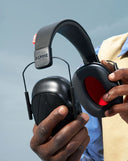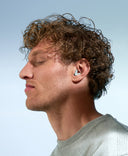Your ears are more important than you might realise. As well as being essential for hearing, they also play a crucial role in maintaining your balance. Pretty special, right? That's why proper protection and safe care are essential. This blog post will tell you everything you need to know about earwax: when it is necessary to clean your ears, and how to do so safely. We also explain why cotton buds are not recommended, and what to do if you have excessive earwax.
Function of earwax
Ears are designed to be largely self-cleaning. Earwax (cerumen) plays a vital role in cleaning and protecting the ear. This amber-coloured substance serves several purposes. Firstly, it serves as a protective coating that prevents dust, dirt and water from reaching and damaging the eardrum and the deeper parts of the ear. It also has a moisturising effect. The acidic nature of earwax inhibits bacterial growth, helping to prevent ear infections. Therefore, earwax in your ear is best left alone. It naturally migrates outwards to the outside of the ear canal, where it can easily be removed.
When to clean your ears?
Your ears have a clever self-cleaning mechanism. Nevertheless, you may want to clean your ears if you suffer from any of the following:
-
Itching, irritation and/or slight pressure in your ear
When earwax dries out, it becomes more difficult to come out naturally. This often causes complaints such as itching. There's nothing more annoying than an itchy ear. You can't reach it! Dried-out earwax can also cause a slight pressure sensation in your ear. Over time, it can also cause pain or blockages. You want to avoid that.
-
Too much earwax
See a lot of earwax on your earplugs or earbuds when you remove them? You may then be tempted to remove as much earwax from your ears as possible. However, you should only remove the earwax that comes out naturally. Increased cerumen production almost always results from damage to the ear canal wall. Poking your ear only makes the problem worse.
-
Dust or dirt in your ears
Have you spent a long time in a dusty or dirty environment, causing dirt to get into your ears? If so, it is advisable to clean your ears. But even then, stick to cleaning the outer ear and the entrance to the outer ear canal. Any dirt that's deeper inside your ear will naturally come out with the earwax.
How to safely clean your ears
What is the best way to clean your ears? It's very simple. For daily cleansing, use a cotton pad, a clean towel or a flannel. Lightly dampen it with warm water, wipe the outside of your ear and then dry it. Remember to also dry the skin behind your ears thoroughly after showering.
You can clean your ears periodically yourself using special ear care products. For the best results, choose an oil-based cleansing solution such as Alpine Hygiene Spray. This natural spray is designed to gently cleanse and care for your ears. It hydrates the inside of the ear, softening the earwax and allowing it to come out. The Dutch Society of Ear, Nose and Throat Medicine also recommends cleaning your ears with oil-based ear care products.
Tip: Is there only water in your ear? Try this!
NEVER clean your ears like this
-
Never push cotton buds, long nails or any other objects into your ear.
-
Avoid using saline solutions, as these will only dry out your ears.
-
Do not use soap or any other cleaning products. These can disrupt the natural balance in your ear, which will only worsen your symptoms.
-
Do not spray water into your ears to clean them. The water pressure from a shower head or tap can damage your eardrum.
Are cotton buds bad for your ears?
Cotton buds are not inherently bad. However, it is better not to clean your ears with them because they can:
-
Cause damage to your ear
Inserting a cotton bud too deeply into your ear can easily cause damage. This can damage the eardrum. If the damage is minor, your body can repair itself, but this will take a few months. A larger eardrum perforation often requires surgical repair.
-
Push earwax deeper into the ear
Although cotton buds are often used to clean the ear, they actually push the earwax that doesn't come out deeper into the ear. This can lead to blockages caused by a build-up of earwax, which can result in impaired hearing, infections and other problems.
-
Cause cotton to break off or be left behind
The cotton on the end of a cotton bud can sometimes fall off. This is particularly unpleasant if it happens in your ear, as it can be difficult to remove. Wooden cotton buds, which are sold as a more sustainable alternative to plastic ones, also pose a risk as they are less flexible and therefore more likely to break.
Suffering from too much earwax?
Here's how to remove earwax from your ears without using cotton buds. To safely remove excess wax or earwax plugs, use an active-formula cleanser. These provide quick relief! To prevent new earwax plugs forming, it is important to keep your ears supple and well hydrated.
Unsure about the best earwax removal solution? Are you experiencing any of the following symptoms: itching, irritation, pain or (slight) pressure in one or both ears? If so, make an appointment to see your GP. They can use a handy device to look inside your ear and check for excessive wax or blockages. Your GP can treat this safely, or refer you to an ear, nose and throat (ENT) specialist if necessary.
This article is for informational purposes only and does not replace medical advice. Have questions about your health? Contact a doctor or healthcare professional.




